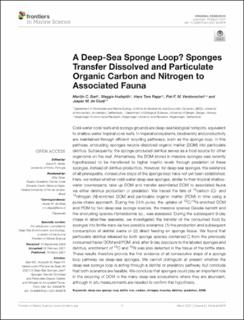| dc.description.abstract | Cold-water coral reefs and sponge grounds are deep-sea biological hotspots, equivalent to shallow-water tropical coral reefs. In tropical ecosystems, biodiversity and productivity are maintained through efficient recycling pathways, such as the sponge loop. In this pathway, encrusting sponges recycle dissolved organic matter (DOM) into particulate detritus. Subsequently, the sponge-produced detritus serves as a food source for other organisms on the reef. Alternatively, the DOM stored in massive sponges was recently hypothesized to be transferred to higher trophic levels through predation of these sponges, instead of detritus production. However, for deep-sea sponges, the existence of all prerequisite, consecutive steps of the sponge loop have not yet been established. Here, we tested whether cold-water deep-sea sponges, similar to their tropical shallow-water counterparts, take up DOM and transfer assimilated DOM to associated fauna via either detritus production or predation. We traced the fate of 13carbon (C)- and 15nitrogen (N)-enriched DOM and particulate organic matter (POM) in time using a pulse-chase approach. During the 24-h pulse, the uptake of 13C/15N-enriched DOM and POM by two deep-sea sponge species, the massive species Geodia barretti and the encrusting species Hymedesmia sp., was assessed. During the subsequent 9-day chase in label-free seawater, we investigated the transfer of the consumed food by sponges into brittle stars via two possible scenarios: (1) the production and subsequent consumption of detrital waste or (2) direct feeding on sponge tissue. We found that particulate detritus released by both sponge species contained C from the previously consumed tracer DOM and POM, and, after 9-day exposure to the labeled sponges and detritus, enrichment of 13C and 15N was also detected in the tissue of the brittle stars. These results therefore provide the first evidence of all consecutive steps of a sponge loop pathway via deep-sea sponges. We cannot distinguish at present whether the deep-sea sponge loop is acting through a detrital or predatory pathway, but conclude that both scenarios are feasible. We conclude that sponges could play an important role in the recycling of DOM in the many deep-sea ecosystems where they are abundant, although in situ measurements are needed to confirm this hypothesis. | en_US |

